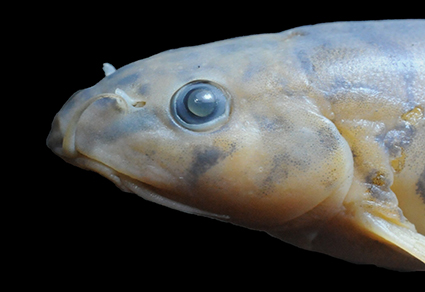Abstract
Paracanthocobitis hijumensis, new species, is described from the Hijum River, a tributary of the upper Brahmaputra River in Arunachal Pradesh, India. Paracanthocobitis hijumensis is distinguished from all five species of the P. zonalternans species complex, viz., P. zonalternans, P. nigrolineata, P. marmorata, P. triangula, and P. phuketensis in having a larger body size (46.5– 65.6 mm SL vs. < 45 mm SL), and a complete (vs. an incomplete) lateral line terminating at the end of caudal peduncle (vs. at or just beyond the dorsal-fin insertion); and from the four species of the P. mandalayensis species complex, P. canicula, P. maekhlongensis, P. mandalayensis and P. pictilis in having a subortibal flap (vs. suborbital groove) in males, and in having fewer dorsal-fin branched rays (9½–10½ vs. 10½–13½), and longer head (23.8–26.0% SL vs. 18.0–20.2). Paracanthocobitis hijumensis, a member of the P. botia complex, differs from the other nine species of this complex by the following combination of characters: presence of an axillary pelvic lobe, greater predorsal distance 47.9–51.8% SL, greater prepelvic distance 52.3–58.8% SL, longer head 23.8–26.0% SL, deeper body 18.4–23.1% SL, smaller eye 14.2–22.5% SL, and fewer branched rays on the dorsal-fin 9½ (12)–10½ (1).
References
Arunkumar, L. & Moyon, W.A. (2019) Paracanthocobitis tumitensis, a new species of zipper loach from Manipur, north-eastern India (Cypriniformes: Nemacheilidae). Species, 20, 101–109.
Grant, S. (2007) A new subgenus of Acanthocobitis Peters, 1861 (Teleostei: Nemacheilidae). Ichthyofile, 2, 1–9.
Grant, S. (2008) Schmerlen der Gattung Acanthocobitis Peters,1861. [Loaches of the genus Acanthocobitis Peters, 1861]. BSSW-Report, 20 (3), 13–18.
Kottelat, M. (1990) Indochinese nemacheilines. A revision of nemacheiline loaches (Pisces: Cypriniformes) of Thailand, Burma, Laos, Cambodia and southern Viet Nam. Verlag Dr. Friedrich Pfeil, München, 262 pp.
Kottelat, M. (2012) Acanthocobitis pictilis, a new species of loach from Myanmar and Thailand (Teleostei: Nemacheilidae). Zootaxa, 3327 (1), 45–52. https://doi.org/10.11646/zootaxa.3327.1.4
Menon, A.G.K. (1987) The fauna of India and the adjacent countries. Pisces. Vol. IV. Teleostei–Cobitoidea. Part 1. Homalopteridae. Zoological Survey of India, Calcutta, x + 259 pp., 16 pls.
Kottelat, M. & Vishwanath, W. (2021) Type locality and synonymy of Paracanthocobitis marmorata and notes on Acanthocobitis (Teleostei: Nemacheilidae). Raffles Bulletin of Zoology, 69, 13–18. https://doi.org/10.26107/RBZ-2021-0003
Rainboth, W. J., Vidthayanon, C. & Yen, M.D. (2012) Fishes of the greater Mekong ecosystem with species list and photographic atlas. Miscellaneous University Of Michigan Publications, Museum of Zoology, University of Michigan No. 201. Museum Of Zoology, Ann Arbor, Michigan, 314 pp.
Singer, R.A. & Page, L.M. (2015) Revision of the zipper loaches, Acanthocobitis and Paracanthocobitis (Teleostei: Nemacheilidae), with descriptions of five new species. Copeia, 103 (2), 378–401. https://doi.org/10.1643/CI-13-128
Singer, R.A., Pfeiffer, J.M. & Page, L.M. (2017) A revision of the Paracanthocobitis zonalternans (Cypriniformes: Nemacheilidae) species complex with descriptions of three species. Zootaxa, 4324 (1), 85–107. https://doi.org/10.11646/zootaxa.4324.1.5


